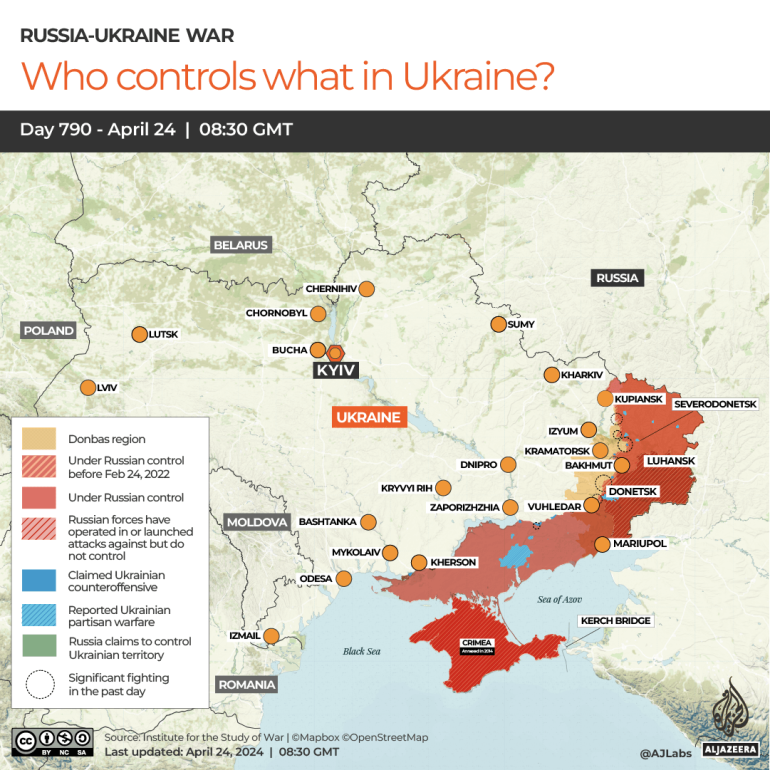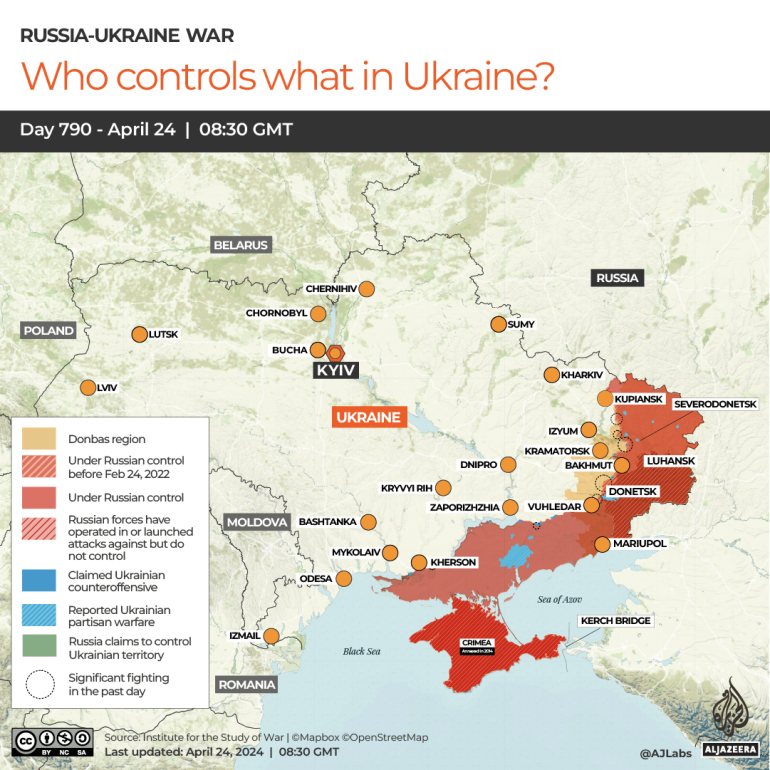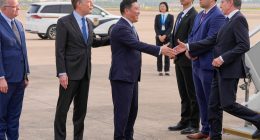Kyiv, Ukraine – Natalya Brovko doesn’t believe that Ukraine will be whole again.
In recent months, Ukrainian forces have been slowly retreating in the eastern Donbas region amid excruciating losses, and top brass warn that the front line may burst open because of dire shortages of ammunition and manpower.
“With all these retreats, I don’t see how we can even get back what we lost,” the 37-year-old mother of two told Al Jazeera.
“I was scared two years ago and now I am scared again,” she said, remembering when Russian forces tried to seize Kyiv and occupied sizeable chunks of four regions in Ukraine’s east and south.
For the first time since the war began in February 2022, fewer than half – 45 percent – of Ukrainians believe that their nation could return to its borders before the 2014 annexation of Crimea, according to a survey by Rating, an independent pollster, released in early April.
A year ago, the figure was 74 percent, Rating said.
At the time, Ukraine was riding high on the success of its counteroffensive in the fall of 2022, when daring manoeuvring forced Russian forces to hastily retreat from most of the northeastern Kharkiv region.
Months earlier, Moscow withdrew its forces from around Kyiv and all of northern Ukraine, and many Ukrainians and observers were confident that Ukrainian forces would swiftly reach the Sea of Azov to bisect Russia’s land bridge between Donbas, where Moscow-backed separatists carved out one of two “People’s republics” in 2014, and Crimea.
But the counteroffensive’s failure filled Ukrainians with pessimism – especially in Russian-occupied areas.
“No one is coming to the rescue, there’s no way we can become part of Ukraine again,” Halyna, who lives in the town of Henichesk in the southern region of Kherson that has been occupied since March 2022, told Al Jazeera.
The perspective of returning Crimea and the Donbas after a decade of separation seems especially impossible – only seven percent of those polled believe in the reconquest.
The pessimism is a combination of several factors.
After more than two years of the conflict, tens of thousands of Ukrainian servicemen have been killed or wounded, millions of civilians fled abroad or to safer areas, and the economy nosedived.
And while Russia ups the ante on the front lines and with almost daily shelling of civilian areas, the public is divided about Ukraine’s new mobilisation law adopted earlier this month, after months of revisions and hundreds of amendments.
There are also concerns about the stability of Western financial and military aid. While new United States weapons could be on the way to Ukraine soon, it took US officials months to finally pass an aid package.
“With all of this in the background, the poll results are quite logical,” Kyiv-based analyst Igar Tyshkevich told Al Jazeera. “But it doesn’t mean they would remain at this level.”
Moscow strives to create an “instability zone” by striking Ukrainian energy infrastructure as blackouts and power shortages affect the economy and raise prices, he said.

Meanwhile, wider, indiscriminate drone and missile attacks on large cities such as Kharkiv in the east and Odesa in the south trigger the flight of civilians to more protected areas in central and western Ukraine.
Russia’s aim is to “create a situation when domestic political pressure grows,” Tyshkevich said.
But some people in border areas are holding up.
“It looks like everyone has gotten used to daily shelling,” said Mykola Akhbash, a police officer in the eastern town of Pokrovsk, that stands just 60km (37 miles) from occupied Avdiivka.
Although some civilians are leaving, “there’s no massive exodus”, he told Al Jazeera.
“Usually, more massive departures begin after a missile hits residential areas. But that doesn’t happen often,” he said. “Although we expect more frequent shelling.”
US ‘double standard?’
Russia has switched to pinpointed strikes on energy infrastructure deep within Ukraine, while its elite forces are being massed to move towards the strategic town of Chasiv Yar in the east.
It is also recalling former mercenaries with the Wagner private army who relocated to central Africa after the August 2023 death of their leader Yevgeny Prigozhin, said Lieutenant General Ihor Romanenko, the former deputy chief of Ukraine’s General Staff of Armed Forces.
In comparison, “the way we amass resources and reserves is difficult and complicated”, Romanenko told Al Jazeera.
Meanwhile, Ukraine is intensifying strikes on Russian oil refineries, military plants and airfields in annexed Crimea and in western Russia, including sites that are more than 1,000 kilometres (621 miles) from the border.
The strikes on oil refineries contradict recommendations from Washington amid fears of oil prices going up – a decision Romanenko dismissed as a “double standard” given the bill to provide $60bn aid to Ukraine was stalled in Congress for months.
“Shall we just watch the way they behave with such hypocrisy, with double standards, and welcome their suggestions?” he said.
Meanwhile, Washington is reluctant to provide Ukraine with fighter jets and missiles.
That, in turn, makes the task of reconquering Russian-occupied areas “complicated and divided in stages” that would include diplomatic efforts, Romanenko added.
He compared the situation with the way Croatia regained the areas it lost during its war for independence between 1991 and 1995.
Return of Crimea ‘absolutely unrealistic’
But foreign observers are far less optimistic.
The return of Crimea “is absolutely unrealistic”, said Nikolay Mitrokhin of Germany’s Bremen University.
Before the failure of Ukraine’s counteroffensive last summer there was a chance to return the annexed peninsula had Ukrainian forces reached the Azov Sea and started shelling the Crimean bridge and the Kerch Strait that divides the Azov and Black seas, he said.
“But now it’s hardly real to penetrate Russian defence farther than the takeover of the Kinburn peninsula,” a fish-shaped area in the southern Mykolaiv and Kherson regions, he told Al Jazeera.
The Kremlin invested billions of dollars in Crimea’s infrastructure and military bases – and cracked down on pro-Ukrainian residents who largely fled to mainland Ukraine.
The situation in the Donbas looks even more desperate, even though Moscow spent significantly less money there and the annexed part of the region is depopulated and destitute after severing economic ties with Kyiv-controlled areas.
“In Donbas, such breakthroughs were not real even last year,” Mitrokhin said.
The best one can expect from Ukrainian forces this year is to prevent the Russian siege of the towns of Kramatorsk and Sloviansk in the northern part of Kyiv-controlled part of Donbas, he said.
In theory, Ukrainian forces have a chance to break through the northern Luhansk region for about 100 kilometres (62 miles) towards the Russian border, he said.
“But it’s meaningless from the military and strategic viewpoints, because it will cost many victims and resources, but will not make northern Luhansk fit for peaceful life even with a truce and the freezing of the conflict,” he said.
Read More: World News | Entertainment News | Celeb News
Al Jazeera








